The Armenian Question
The great Game, 19th Century Flowering, the Cross and Sword
Tour Armenia
THE GREAT GAME, GREAT SWITCH 19th CENTURY DEVELOPMENTS THE CROSS AND THE SWORD
The Great Game, Great Switch
The seeds of the genocide and the creation of the Caucasian States go back much further than the 19th century, but key events that occurred following the Russian-Turkish War in the 1870's, led to cataclysmic results and tensions that continue to the present day. Politically these events revolved around the "Great Game" between the World Powers (Great Britain, France and Germany, and later, the USA), and the Eastern Powers (Russia and the Ottoman Empire). Economically they were promoted by the discovery of oil in the Caspian Sea, and French and British moves to secure the commodity for their own purposes. There are lessons to be learned in the Great Game, with haunting shadows of events that are being played out today as World Powers squabble over pipeline routes through the Caucasus, pitting local republics against each other in the process.
One of the key issues in treaty negotiations at Berlin in 1878 following the victory of Russia over Turkey, was the Armenian Question. The question regarded the protection and rights of key minorities in the Ottoman Empire following its defeat. One of the representatives for Armenia that attended the treaty conference was Khrmian Hairik, who had been Patriarch of Alexandropolis until, he resigned in 1873 in response to increasing persecution against Armenians. Khrmian was a formidable politician, able to mobilize Russian and Great Power negotiators to demand freedoms for the nationalities living in the Ottoman Empire. He and other Armenian representatives (including Hovhannes Cheraz) succeeded in placing the Armenian Question before the conference, despite Turkish (and German, which supported Turkey) resistance. Article 61 of the treaty guaranteed autonomy of Armenia along with Bulgaria, Hungary, Macedonia and Bosnia Herzegovina. Ironically, had Article 61 been implemented on Armenia's behalf, there is little doubt among some that Armenia would have become a Republic much earlier, avoiding the events that followed. Isolated on the eastern part of the Turkish Empire, and not fully supported by Russia, which wanted to protect its control over Eastern Armenia, other events developed at the conference.
German representatives at the Berlin conference, led by Bismarck, persuaded the Great Powers to switch Article 61 for Article 16 in the case of Armenians and other minorities living in Ottoman controlled Anatolia. Article 16 stipulated that Christian nationalities were independent inside of Turkey, with freedom to create schools, and freedom of religion and ideas. It did not give them autonomy, merely assuring their right to exist inside of the Ottoman Empire. As such, the great switch from Article 61 to Article 16 crushed all hopes of an independent Armenia, and the Armenian representatives returned from the conference feeling betrayed. Khrmian reported,
"Its ironic. It's like they (Great Powers) gave us harissa (a traditional porridge with shredded chicken). Each of the big countries (Bulgaria, Hungary) took out their metal ladle and took his part from the harissa and became independent. But my ladle was made of paper. How can I take my part with a paper ladle? I forgot to bring someone from Zeitun with me. They have their own metal ladle." The region of Zeitun in Western Armenia had successful insurrections against Ottoman control, fighting off overwhelming forces in 1860, 1862 and 1870. Just before the Russian-Turkish war in 1875, the citizens of Zeitun beat the corrupt Ottoman governor and evicted him from their lands.
Russia had been outwitted as well, being awarded a few territories of Eastern Anatolia (Kars, Sari Ghamish, Ardan and Alashkert). The threat against Armenians were realized immediately following the 1878 Berlin conference when Turkey, understanding that the great Powers would not interfere, began ruthless oppression against minorities. This was highlighted by the Sultan Hamid genocide in the same year, where ethnic Armenians, Greeks and Assyrians were murdered at Adana, Zeitun, Musalehr, Sebastia, Marish, Cilicia, among others, on the pretext of inciting insurrection against the state (though ethnic hatred played as large a part in the affair). At Adana alone 30-50,000 minorities were killed. This 'first genocide' is remembered in song and the book "40 Days at Musalehr," which later became a film.
The Cross and the Sword
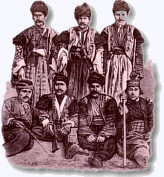 Khrmian, feeling he had completely failed, resigned from all public life, and began writing. The Ottoman Turks still governed over half of the Armenian land and population (Western Armenia) after the 1878 Treaty. In this same period an active campaign of guerilla war ensued, led by Armenian fighters, popularly known as Fedayi, an Arab word. The Armenian title given was Azgi Zinvor (Soldier of the Nation, or Freedom Fighter). One the leaders of this movement was Andranik Ozanian, born in 1865 in Shopin Garahisar. Andranik was trained as a carpenter, following his father's trade until the age of seventeen, when his father was beaten by a Turk. Andranik retaliated by beating the man who attacked his father, and was forced to run away. He joined the guerilla campaign, becoming a leader in the 1880's. Khrmian, feeling he had completely failed, resigned from all public life, and began writing. The Ottoman Turks still governed over half of the Armenian land and population (Western Armenia) after the 1878 Treaty. In this same period an active campaign of guerilla war ensued, led by Armenian fighters, popularly known as Fedayi, an Arab word. The Armenian title given was Azgi Zinvor (Soldier of the Nation, or Freedom Fighter). One the leaders of this movement was Andranik Ozanian, born in 1865 in Shopin Garahisar. Andranik was trained as a carpenter, following his father's trade until the age of seventeen, when his father was beaten by a Turk. Andranik retaliated by beating the man who attacked his father, and was forced to run away. He joined the guerilla campaign, becoming a leader in the 1880's.
The Catolicos Mahkar died in 1882, and Khrmian was elected to serve in his place. The election had to be approved by the Russian Czar, and Czar Alexander III resisted the appointment until 1883, fearing that under the leadership of Khrmian the Armenians in the Russian Empire would assert their independence. Alexander III had initiated a period of repression in the empire following the death of his father Alexander II by an assassin's bomb. Reluctantly Alexander III consented to the appointment, but he began to include Armenians into the pogroms against Jews living in the empire.
Khrmian's strengths soon asserted themselves when the Vice Czar for the Caucasus, Golitsin, ordered his Commissioner for Armenia, Nagashidzeh, to confiscate the Armenian Church treasury at Echmiadzin and claim it as Czarist property. Khrmian refused, and Nagashidzeh was ordered to Echmiadzin (then called Vagharshapat), to take the treasury by force. The population gathered around the city and cathedral, thinking that Nagashidzeh would kill their Catolicos. Fearing for his life, Nagashidzeh resorted to plea bargaining, reportedly telling the Catolicos, "Have mercy on me! The Vice Czar will kill me if I do not take the treasury back. I am the father of four children."
Khrmian replied, "You are the father of four children. How will I answer to my 4 million children if I do this thing?" Nagashidzeh returned empty-handed, but the attempt was considered an act of war by freedom fighters, and an attempt was made to assassinate Golitsin, and Nagashidzeh's carriage was bombed. A series of reprisals against Armenians followed.
19th Century Developments: A new Golden Era
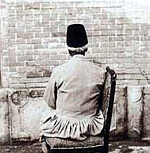 The history of Eastern Armenia turned out differently. After its joining Russia it began to develop capitalist relations. The newborn Armenian bourgeoisie invested its capital in the trade and industrial centres of Transcaucasia -Baku, Tiflis and Batum. Productive forces began to develop, and relations with the markets of Central Russia were established, Armenia exporting cotton for the textile industry, leather for the footwear industry and Armenian rugs, grape wines, brandies, canned fruit and so-called Swiss cheese to many Russian towns. The history of Eastern Armenia turned out differently. After its joining Russia it began to develop capitalist relations. The newborn Armenian bourgeoisie invested its capital in the trade and industrial centres of Transcaucasia -Baku, Tiflis and Batum. Productive forces began to develop, and relations with the markets of Central Russia were established, Armenia exporting cotton for the textile industry, leather for the footwear industry and Armenian rugs, grape wines, brandies, canned fruit and so-called Swiss cheese to many Russian towns.
But the mining and metallurgical industries began to play an even more important role, particularly the copper industry. Exploitation of the copper ores in Alaverdi and Zangezur was intensified, the industry gradually being taken over by foreign capitalists -French concessionaires. Railways, including the Tiflis-Alexandropol-Kars and the Alexandropol-Erivan-Dzhulfa, were built at the end of the 19th and the beginning of the 20th centuries. The country was drawn into extensive economic relations.
Remarkable novelists and educators made their appearance at that time. Khachatur Abovian (1805-1848), "the father of modern Armenian literature", was a writer and teacher. He wrote the Wounds of Armenia, his patriotic masterpiece, in 1840.
Abovian linked the liberation of Armenia with Russia and praised "the hour when the Russians stepped on Armenian soil". His successor, Mikael Nalbandian (1829-1866), revolutionary democrat, philosopher, writer and publicist, Hertzen's and Ogaryov's comrade-in-arms, called on the people to fight against all tyranny, exploitation and colonial oppression. He considered the victory of a revolution in Russia the only guarantee of the Armenians' freedom.
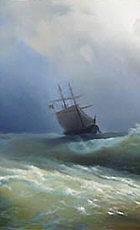 The outstanding writers Raffi, Rafael Patkanian, Smbat Shakhaziz, Perch Proshian, Gazaros Agaian, Muratsan Shirvanzade, Nar-Dos, the playwright Gabriel Sundukian, and the poets- Ovanes Tumanian, Hakop Hakopian, Avetik Isaakian, Hovanes Hovanesian, Vahan Terian and many others produced fiction and poetry comparable to the world's best. Towards the end of the 19th century 246 newspapers and journals were being published in Armenian all over the world, and at the beginning of the 20th century their number increased to 724. Many books were also being published, including works by Armenian writers and translations from English, Russian, French, German and other languages. The outstanding writers Raffi, Rafael Patkanian, Smbat Shakhaziz, Perch Proshian, Gazaros Agaian, Muratsan Shirvanzade, Nar-Dos, the playwright Gabriel Sundukian, and the poets- Ovanes Tumanian, Hakop Hakopian, Avetik Isaakian, Hovanes Hovanesian, Vahan Terian and many others produced fiction and poetry comparable to the world's best. Towards the end of the 19th century 246 newspapers and journals were being published in Armenian all over the world, and at the beginning of the 20th century their number increased to 724. Many books were also being published, including works by Armenian writers and translations from English, Russian, French, German and other languages.
Other forms of art were likewise developing. In 1827, i.e., immediately after the liberation of Yerevan, A. S. Griboyedov's play Wit Works Woe was produced on the Yerevan stage for the first time in Russia in the presence of the author. A new period in the 2,000 years of the Armenian theater's history was ushered in the second half of the 19th century by the appearance of professional theaters. The great actors Petros Adamian and Siranuish reenacted for the first time on the Armenian stage the Shakespearean characters of which the Armenian spectators had become so fond . Tigran Chukhadzhian composed the first Armenian operas, Arshak II and Karine. Armenian musical culture was developed in the classical, deeply national works of Komitas.
Armenian painting also flourished. Miniatures decorating manuscript books had been the dominating genre of medieval painters, whereas in the 17th and 18th centuries easel painting appeared and portrait, everyday-life, landscape and other genres developed. Nakhash Ovnatan and Minas Dzhugaetzi had won renown during this period, while Akop Ovnatanvan . Ovanes (Ivan) Aivazovsky, world-famous painter of seascapes, Vardges Surenyants, Emanuil Makhtesian, Gevorg Bashinjagian, etc., became famous in the 19th and the beginning of the 20th centuries.
The Beginning of Genocide
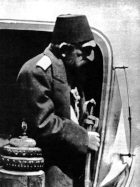 In the West, the increasingly reactionary politics of the Ottoman Empire, combined with independent movements within the Armenian community, culminated in a series of massacres throughout the Armenian provinces in 1894-96 (The Hamid Genocide), where 100s of thousands of Armenians were killed. In retaliation, Freedom fighters increased guerilla warfare, and Andranik (who by now had the popular title Andranik Pasha) became a famous commander. The Turks grew to fear him, saying that, "bullets never touched the Pasha." In reality he was shot during battles, but survived all wounds. A seminal battle for Andranik was fought in 1901 at Arakelotz Vank in Mush Region. Andranik had about 30 men under his command at the time, and had gone to the monastery, where 100 civilians with 80 orphans were holed up. They were surrounded by 3000 Turkish soldiers, which were joined by several army units, making up 10,000 men. Andranik and his 30 men successfully fought off the Turkish forces for almost a month before they had to retreat. In the dead of night they took the entire civilian population and escaped through the midst of the Turkish army without being detected. His fame spread as a result of the feat. When Andranik moved to Geneva and then Bulgaria In 1905 he wrote the book, "The Army Orders", which laid out the principals of guerilla warfare and strategy, the first of its kind written in Armenian, and which influenced Armenian strategies in warfare for decades. In the West, the increasingly reactionary politics of the Ottoman Empire, combined with independent movements within the Armenian community, culminated in a series of massacres throughout the Armenian provinces in 1894-96 (The Hamid Genocide), where 100s of thousands of Armenians were killed. In retaliation, Freedom fighters increased guerilla warfare, and Andranik (who by now had the popular title Andranik Pasha) became a famous commander. The Turks grew to fear him, saying that, "bullets never touched the Pasha." In reality he was shot during battles, but survived all wounds. A seminal battle for Andranik was fought in 1901 at Arakelotz Vank in Mush Region. Andranik had about 30 men under his command at the time, and had gone to the monastery, where 100 civilians with 80 orphans were holed up. They were surrounded by 3000 Turkish soldiers, which were joined by several army units, making up 10,000 men. Andranik and his 30 men successfully fought off the Turkish forces for almost a month before they had to retreat. In the dead of night they took the entire civilian population and escaped through the midst of the Turkish army without being detected. His fame spread as a result of the feat. When Andranik moved to Geneva and then Bulgaria In 1905 he wrote the book, "The Army Orders", which laid out the principals of guerilla warfare and strategy, the first of its kind written in Armenian, and which influenced Armenian strategies in warfare for decades.
Meanwhile, in Czarist Armenia (now led by Czar Nicholas II), Armenian schools, newspapers and libraries were closed and church property confiscated to head off anticipated insurrection. The repression increased following the Russian defeat in the Russian-Japanese war of 1904, when the entire Russian Baltic fleet was sunk trying to defend Port Arthur.
On January 9, 1905, 200,000 Russian citizens marched to the Winter Palace in St. Petersburg to petition the Czar, and soldiers opened fire on the unarmed crowd, killing several hundred. The country went into anarchy in the events that followed (called the 1905 revolution), with the several new worker councils, or soviets, successfully leading strikes against the government. Among the new leaders of the soviet movement were several Marxists, and a new Marxist movement in Tbilisi was formed, with many Armenian and Georgian members who felt that only through revolution against the corrupt Czarist rule could they achieve independence. Among these members were two to have profound impact on the Caucasus region, Stepan Shahumian and Iosif Dzhugashvili, who later took the name Stalin, which means Man of Steel. It is against this background that increasing repression and pogroms should be seen, as the two formerly great powers of Turkey and Russia became increasingly ruthless in suppressing attempts to assert independence (which to them meant the end of their dynasties).
On October 29, 1907, Catolicos Khrmian died and was buried at Echmiadzin Cathedral. Khrmian was honored with the only white marble monument over his grave, and was a loss to the nation. He protected not only Armenians, but Kurds, Assyrians and Jews living in the Armenian territories. On his death, and following the events of the 1905 revolution, Russians and Turks increased repression against Armenians under their control. For years the freedom fighters had been receiving arm shipments and supplies from Eastern Armenia, and Russian attempts to cut off this supply line (fearing the guns would soon be turned against them), erupted in a series of conflicts and pogroms.
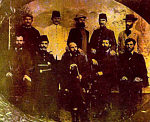 The Ottoman Empire might have died much earlier were it not for the rise of the Young Turk movement in 1908, ironically formed to create a democratic republic, but which soon transformed itself into a nationalistic political movement. The Young Turks first courted the Armenian population, and several intellectuals joined the party. There was hope that minority groups like Armenians and Greeks would receive more tolerance under a government led by the Young Turks, (who had as one of their members a young Mustafa Kemal, later known as Ataturk). Only Andranik seemed to understand that the Young Turks could not be trusted, believing they would prove to be worse than the Pashas. The Young Turks sadly proved Andranik right, killing a further 30,000 Armenians living in Adana in the spring of 1909. The Ottoman Empire might have died much earlier were it not for the rise of the Young Turk movement in 1908, ironically formed to create a democratic republic, but which soon transformed itself into a nationalistic political movement. The Young Turks first courted the Armenian population, and several intellectuals joined the party. There was hope that minority groups like Armenians and Greeks would receive more tolerance under a government led by the Young Turks, (who had as one of their members a young Mustafa Kemal, later known as Ataturk). Only Andranik seemed to understand that the Young Turks could not be trusted, believing they would prove to be worse than the Pashas. The Young Turks sadly proved Andranik right, killing a further 30,000 Armenians living in Adana in the spring of 1909.
The First and Second Balkan Wars were seminal in rallying Armenian resistance and creating a unified Freedom Fighter force. The First Balkan War in 1912 pitted Serbia, Bulgaria and Greece against Turkey, wresting further lands and independence from the Ottomans. Andranik trained volunteers in Bulgaria to fight Turkey from Bulgaria, which greatly helped Bulgaria winning independence. Resisting efforts to join political parties, Andranik considered his duties to "become a member of downtrodden nations", and his over-riding concern was fighting Turkey. One of the men who joined Andranik's Volunteers was the Armenian Garegin Nezhdeh, who had studied at the Officer's Academy in Bulgaria. Nezhdeh soon became a commander for one Andranik's units, fighting by his side. Andranik's successes included pinning down 10,000 Turkish soldiers at Maritsaget with only 250 men. In 1913, the Bulgarian King Ferdinand conferred on Andranik the rank of Lieutenant-Colonel and made him an honorary citizen of the country.
The First Balkan War was followed by the Second Balkan War in 1913, when Serbia and Greece fought Bulgaria. On September 1, 1914, World War I began, with Turkey joining the Axis side. Andranik returned to Armenia in the same year to continue fighting the Turkish army.


 Top
Top

|
